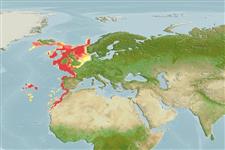Common names from other countries
Classification / Names / Names
आम नाम | उपशब्द | Catalog of Fishes (gen., sp.) | ITIS | CoL | WoRMS
Environment: milieu / climate zone / depth range / distribution range
पारिस्थितिकी
; गहराई सीमा 37 - 750 m (Ref. 356). Temperate; 71°N - 22°N, 34°W - 7°E
Eastern Atlantic: from Morocco to Atlantic coast of Europe and southern coast of Iceland.
Length at first maturity / आकार / वज़न / Age
Maturity: Lm 10.5, range 13 - ? cm Max length : 22.1 cm CW पुल्लिंग / अलिंग; (Ref. 2761); अधिकतम प्रकाशित वज़न: 1.9 kg (Ref. 2761)
Maximum carapace width: 20.0 cm (Ref. 435). Higher rate of female individuals in shallower strata, 200 to 400 m, and male individuals has a higher rate in deeper strata, 400 to 600 m. Landings of 10,000 per year (Ref. 2753). Unimodal size frequency distribution for both sexes (Ref. 2753, 2761). Occurs at depths from 37 to 700 m (Ref. 2761; 150 to 750 m in Ref. 356; 37 to 620 m in Ref. 435; and sublittoral to 700 m in Ref. 2753). Found on varied substrata (Ref. 2761). In general, species under the family Cancridae are omnivores, predators, or scavengers (Ref. 3477)
Life cycle and mating behavior
परिपक्व अवधि | पुनरुत्पत्ति | मछलीऔ का अंडे देना | अंडे | Fecundity | लार्वा
Exhibits spawning migration that results in ovigerous females occupying different territory from the rest of the population (Ref. 2753).
Fischer, W., G. Bianchi and W.B. Scott (eds.). 1981. (Ref. 435)
IUCN Red List Status (Ref. 130435)
CITES status (Ref. 108899)
Not Evaluated
Not Evaluated
Human uses
मात्स्यिकी: व्यापारिक
| FishSource | Sea Around Us
साधन
इंटरनेट स्रोत
Estimates based on models
Preferred temperature
(Ref.
115969): 6.8 - 14.1, mean 9.6 (based on 211 cells).
लौटाव
ऊंचा, न्यूनतम जनसंख्या दुगनी समय अवलागत 15 महीने। (Fec=484,800).
Vulnerability
Low vulnerability (10 of 100).
Price category
Unknown.
